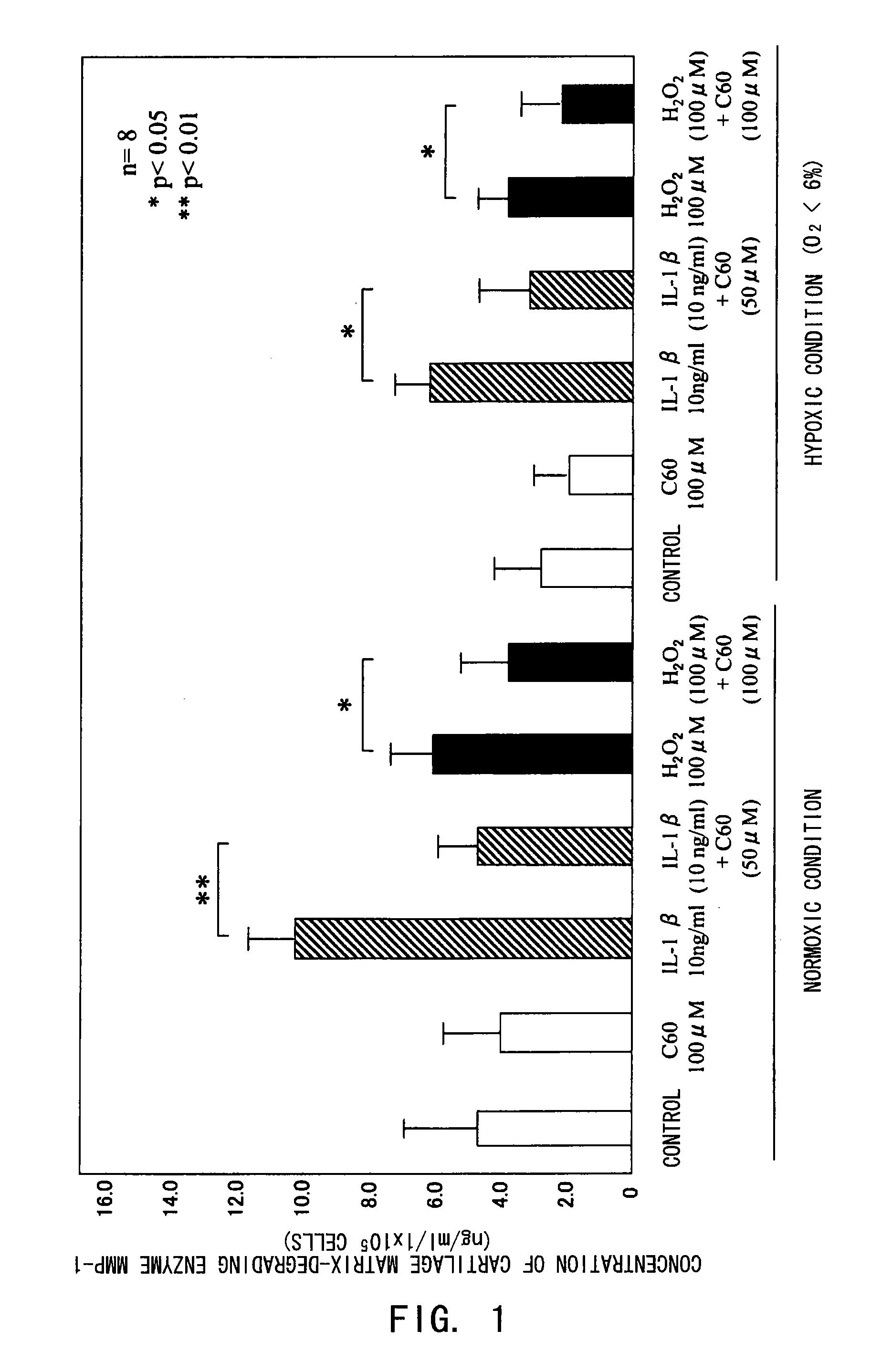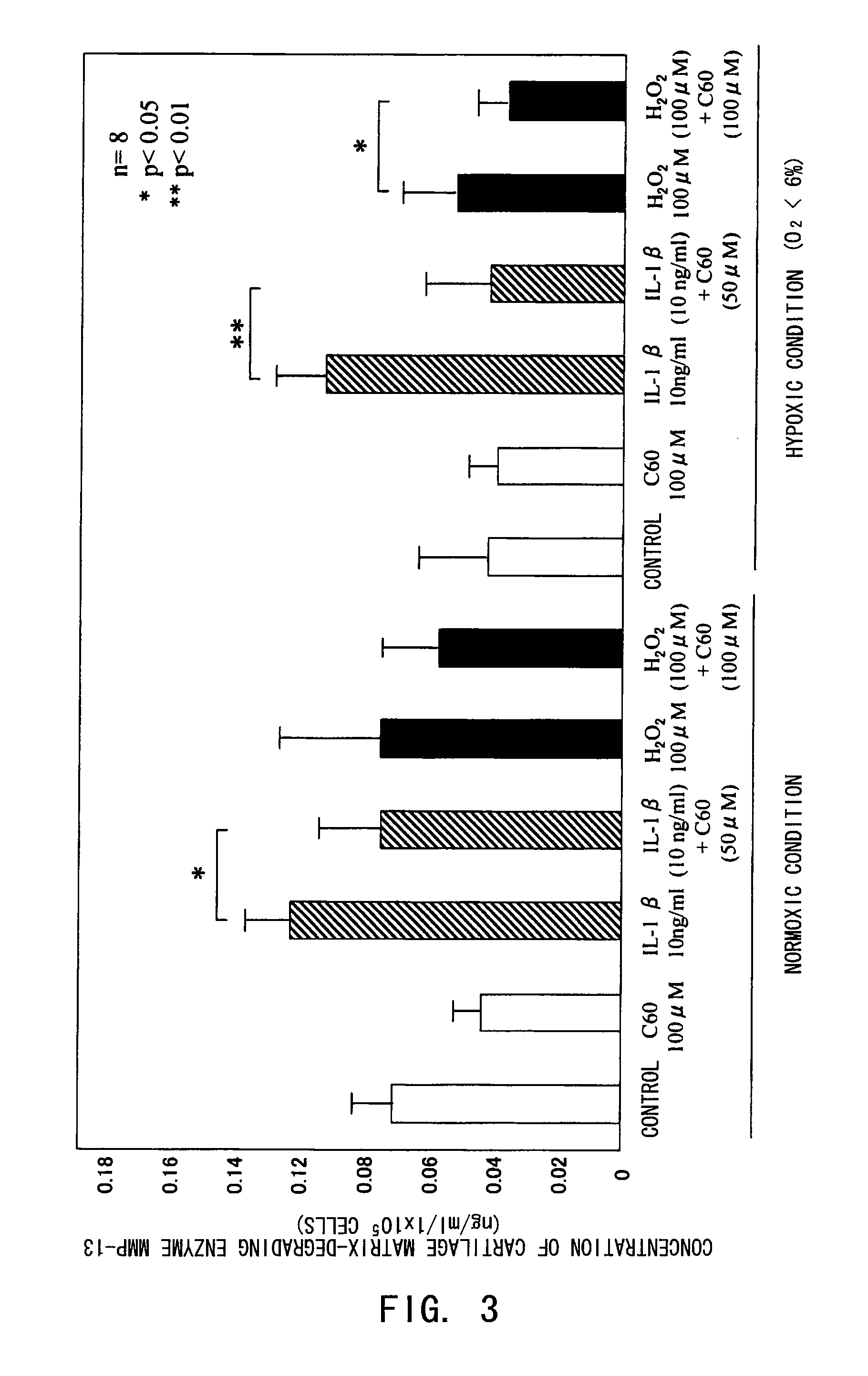Pharmaceutical compositions for treating/preventing motor organ diseases
a technology of pharmaceutical compositions and motor organs, applied in the field of pharmaceutical compositions for treating/preventing motor organ diseases, can solve the problems of poor repairability of articular cartilage tissues, patients are forced to replace artificial joints, and the effect of reducing activity, life span and functions
- Summary
- Abstract
- Description
- Claims
- Application Information
AI Technical Summary
Problems solved by technology
Method used
Image
Examples
example 1
Influence on Cultured Chondrocytes
[0081]The inhibitory effect of fullerenes having a strong oxidative stress (oxygen free radical) scavenging ability on motor organ degeneration was examined from the viewpoint of cell biology / pharmacology.
(1) Culture of Osteoarthritis Patient-Derived Chondrocytes
[0082]Chondrocytes isolated from human articular cartilage tissues were used for cultured cells. After obtaining informed consent, cartilage tissues were collected from surgically-removed tissues from eight osteoarthritis patients. The collected tissues were sliced and then treated in a liquid low-glucose Dulbecco's modified Eagle's medium (DMEM, manufactured by Gibco Co.) containing 1.5 mg / ml collagenase B at 37° C. overnight, to isolate chondrocytes for culture. The cells were normally cultured in a culture flask (culture area: 25 cm2), and in a polystyrene culture dish (diameter: 6 cm) for use in the experiments. The cell culture was performed using a DMEM medium added with inactivated fe...
example 2
Inhibition of Cartilage Degeneration by Fullerene using Osteoarthritis Model Rabbits whose Knee Joint Ligaments were Excised
(1) Preparation of Osteoarthritis (Cartilage Degeneration) Rabbit Model
[0099]Osteoarthritis animal model was prepared according to a general method. NZW-strain male rabbits (2 to 2.5 kg, purchased from Kitayama Labes Co.) were habituated for about one week, and both knee joint sites were shaved and disinfected with an iodine antiseptic agent under anesthesia with a combined administration of ketamine hydrochloride and xylazine (intramuscular administration, or intravenous administration if the anesthetic effect was low). The epidermis inside the knee joints was incised to expose the anterior cruciate ligament and medial collateral ligament, which were then cut out. After confirming and incising the articular capsule, the medial meniscus was exposed and totally extracted. Tissues around the articular capsule, patellar tendon, and epidermis were sutured thereafte...
example 3
Examination of Lubricating Effect of Fullerene
[0119]Lubricating effect of fullerene was examined using three different solutions. 20 ml each of the solutions of (A) osteoarthritis patient-derived synovial fluid, (B) 50% polyethylene glycol solution, and (C) joint function-improving agent (hyaluronic acid formulation) were prepared, and dispensed into two tubes at 10 ml each. One 10 ml solution was mixed with fullerene (C60) to adjust the final concentration to 1.0 μM. The other 10 ml solution was used as a control solution. The dynamic friction coefficients of the respective solutions at room temperature were measured three times by a pendulum-type dynamic friction coefficient measuring apparatus (Japan Lubricating Oil Society), and the mean values were calculated. The dynamic friction coefficients were compared between the fullerene solutions and the control solutions.
[0120]As a result, in all three types of above solutions, dynamic friction coefficient showed a decreasing tendency...
PUM
 Login to View More
Login to View More Abstract
Description
Claims
Application Information
 Login to View More
Login to View More - R&D
- Intellectual Property
- Life Sciences
- Materials
- Tech Scout
- Unparalleled Data Quality
- Higher Quality Content
- 60% Fewer Hallucinations
Browse by: Latest US Patents, China's latest patents, Technical Efficacy Thesaurus, Application Domain, Technology Topic, Popular Technical Reports.
© 2025 PatSnap. All rights reserved.Legal|Privacy policy|Modern Slavery Act Transparency Statement|Sitemap|About US| Contact US: help@patsnap.com



